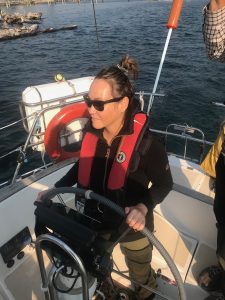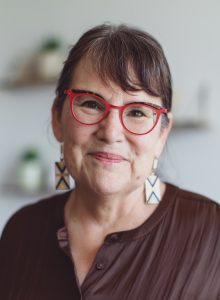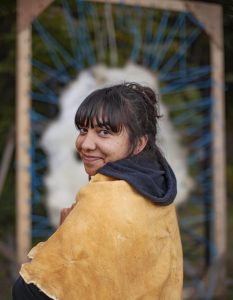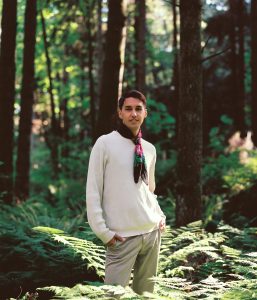2025 Indigenous Art Intensive
Keynote Speakers
Joseph Naytowhow
Artists-in-Residence
Judy Anderson
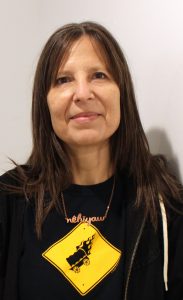 Judy Anderson is nêhiyaw from Gordon First Nation, Treaty 4, Saskatchewan. Her practice includes beadwork, installation, three-dimensional pieces, painting, and collaborative projects; her work focuses on spirituality, family, colonization, decolonization, and nêhiyaw ways of knowing and being. Her current work is created with the purpose of honouring people in her life and nêhiyaw intellectualizations of the world. She is a Professor of Canadian Indigenous Studio Art in the Department of Art and Art History at the University of Calgary.
Judy Anderson is nêhiyaw from Gordon First Nation, Treaty 4, Saskatchewan. Her practice includes beadwork, installation, three-dimensional pieces, painting, and collaborative projects; her work focuses on spirituality, family, colonization, decolonization, and nêhiyaw ways of knowing and being. Her current work is created with the purpose of honouring people in her life and nêhiyaw intellectualizations of the world. She is a Professor of Canadian Indigenous Studio Art in the Department of Art and Art History at the University of Calgary.
Marie-Anne Redhead
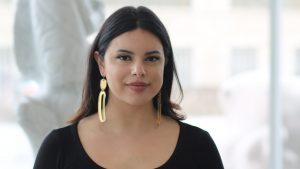
Marie-Anne Redhead (she/her) is the Assistant Curator of Indigenous and Contemporary Art at the Winnipeg Art Gallery-Qaumajuq. She holds a Bachelor of Arts (Honours) degree in English from the University of Winnipeg, where she is expected to graduate from her MA in Curatorial Studies this fall. Her creative practice includes writing, beading, and drawing; and her curatorial focus is on destabilising settler normativity in Canadian art while centering Indigenous survivance, resistance, and futurity.
She is Ininiw & francophone and is a member of Fox Lake Cree Nation.
Nicole Neidhardt

Nicole Neidhardt is a Diné (Navajo) multi-disciplinary artist and illustrator originally from Santa Fe, NM. She received her MFA from OCAD University in Toronto, Ontario, and a BFA with a business minor from the University of Victoria. Nicole’s Diné identity is the heart of her practice which encompasses illustration, installation, murals, and Indigenous Futurisms. Her multi-disciplinary practice centers and uplifts Indigenous worldviews and voices in order to contribute to strong and vibrant Indigenous futures. She has illustrated the books “When We Are Kind,” ”Braiding Sweetgrass for Young Adults,” and ”Circle of Love.”
Peter Morin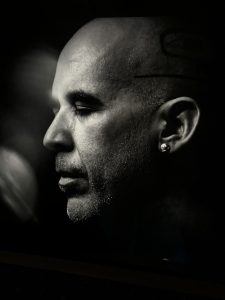
Peter Morin is a grandson of Tahltan Ancestor Artists. Initially trained in lithography, Morin’s artistic practice moves from Printmaking to Poetry to Beadwork to Installation to Drum Making to Performance Art. Morin’s artistic offerings can be organized around four themes: articulating Land/Knowing, articulating Indigenous Grief/Loss, articulating Community Knowing, and understanding the Creative Agency/Power of the Indigenous body. The work takes place in galleries, in community, in books, in collaboration, and on the land. All of the work is informed by dreams, Ancestors, Family members, and Performance Art as a Research Methodology. Throughout his exhibition and making history, Morin has focused upon his matrilineal inheritances in homage to the matriarchal structuring of the Tahltan Nation, and throughout his art work/history he has prioritized Cross-Ancestral collaborations. Peter Morin currently holds a tenured appointment in the Faculty of Arts at the Ontario College of Art and Design University in Toronto. Peter is the son of Janelle Creyke (Crow Clan, Tahltan Nation) and Pierre Morin (French-Canadian).
Serena Steel
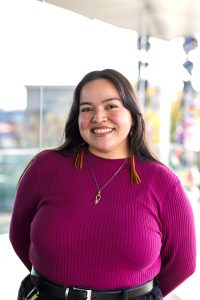
Serena Steel is a Secwépemc interdisciplinary artist and curator from Simpcw First Nation whose practice takes the form of beadwork, sculpture, and writing. Her work revolves around belonging in relation to the land and the people who she comes from. Steel currently works on the unceded territories of the xʷməθkʷəy̓əm (Musqueam), Sḵwx̱wú7mesh (Squamish), and səlilwətaɬ (Tsleil-Waututh) Nations. She holds a Bachelor of Fine Arts in Critical and Cultural Practice from Emily Carr University of Art + Design with a minor in Social Practice and Community Engagement.
Les Louis

Les Louis is Okanagan/Shuswap and is a member of the Lower Similkameen Indian Band, part of the Okanagan (Syilx) Nation. He has received a Diploma in Fine Arts from Okanagan University College in Kelowna BC, Canada. He also received an Associate Degree in Fine Arts from the Institute of American Indian Arts in Santa Fe, New Mexico, U.S.A. He now resides in the Similkameen Valley at his homestead with his wife and their children. They are a creative family and are also working on language revitalization in their community.
Les is a vivid artist and has explored many disciplines from drawing, jewelry, photography, painting, ceramics, and traditional techniques. Les has recently found a new passion in sculpture and is bringing his ideas to life and life-size, although he still continues to work in many other mediums. He enjoys wood-working, making rawhide rattles, hand-drums, pow-wow drums, and drumsticks. His creativity stems from various influences, but none so important as his culture, language, traditions, and mother nature. Les is motivated to explore his love for art and portray that in every piece he creates. His passion is expressed in all his works, as he incorporates nature and all its wonders. His Okanagan name is Miwlna? which translates to, “wherever he goes, he is in the middle of things, in the middle of it all.”
Miwlna? enjoys being able to share his Culture through his artwork, he finds himself being a resource person to share his skills, experiences, knowledge and perspectives to broaden peoples understanding of Indigenous ways of being.
In his journey, Miwlna draws upon the examples of the Interior Pictograph designs located throughout his Traditional Territory, as one of his many influences. It is his love for the simple yet complex meaning these images can have that challenge him to express that in new and thoughtful pieces.
Catherine Blackburn
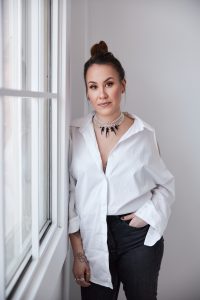 Catherine Blackburn was born in Patuanak Saskatchewan and is a member of the English River First Nation (Denesųłiné). She is a multidisciplinary artist and jeweller, whose narrative work often addresses Canada’s settler-colonialism. Her work grounds itself in the Indigenous feminine and is bound through the ancestral love that stitching suggests. Through stitchwork, she explores Indigenous sovereignty, decolonization and representation. Her work has exhibited in notable national and international exhibitions including: Radical Stitch, Àbadakone, Santa Fe Haute Couture Fashion Show and Toronto Indigenous Fashion Week. She has received numerous awards for her work including the Sobey Art Award longlist (2019/2023), a Forge Residency Fellowship (2022), and an Eiteljorg Fellowship (2021).
Catherine Blackburn was born in Patuanak Saskatchewan and is a member of the English River First Nation (Denesųłiné). She is a multidisciplinary artist and jeweller, whose narrative work often addresses Canada’s settler-colonialism. Her work grounds itself in the Indigenous feminine and is bound through the ancestral love that stitching suggests. Through stitchwork, she explores Indigenous sovereignty, decolonization and representation. Her work has exhibited in notable national and international exhibitions including: Radical Stitch, Àbadakone, Santa Fe Haute Couture Fashion Show and Toronto Indigenous Fashion Week. She has received numerous awards for her work including the Sobey Art Award longlist (2019/2023), a Forge Residency Fellowship (2022), and an Eiteljorg Fellowship (2021).
Faye HeavyShield

Born in 1953, Faye HeavyShield entered the Canadian contemporary art scene during her third year at the Alberta College of Art and Design in Calgary, Alberta in 1983 and has since inspired several generations through her work as an artist, mentor, and writer. While many notable Blackfoot artists have been men, Faye’s work grows out of her experience as a Blood woman and cultural matriarch, resulting in a potent minimalist aesthetic that differentiates her from other senior artists of her territory. HeavyShield has exhibited in solo and group exhibitions nationally and internationally, including: Nations in Urban Landscapes at the Contemporary Art Gallery in Vancouver, BC; rock paper river at Gallery Connexion, Fredericton, NB; Into the Garden of Angels at The Power Plant in Toronto, ON; blood at the Southern Alberta Art Gallery; Land, Spirit, Power at the National Gallery of Canada; Close Encounters: The Next 500 Years at Plug In Institute of Contemporary Art in Winnipeg, MB; and Hearts of Our People: Native Women Artists at the Minneapolis Institute of Art. Her work is found in the collections of the Alberta Foundation for the Arts, Glenbow Museum, Heard Museum (Phoenix), Kelowna Art Gallery, MacKenzie Art Gallery, McMichael Canadian Art Collection, National Gallery of Canada, and Nickle Galleries (Calgary).
Marcy Friesen
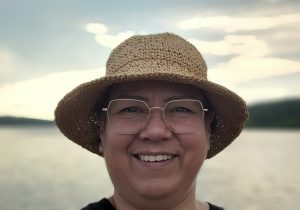
Marcy Friesen is of Swampy Cree and Welsh ancestry and currently resides on a mixed farm with her family near Carrot River, SK. She comes from a long line of traditional master beaders and talented creative family members. Friesen has always felt the need to create and started her career with a small business making utilitarian objects such as mitts, hats and mukluks. After visiting an art gallery and working with her mentor, she changed her practice to experimenting with an artisanal craftsmanship that exists outside the traditional spectrum of beauty and utility. Threading through beads, leather, and furs, Friesen draws the viewer into an intimate experience using her honed skills and intuitive sensibilities toward material, colour, and presentation. In Friesen’s practice, the natural and synthetic come together in ways that are inclusive of the contemporary condition, transforming ways of understanding and expectations of cultural production.
Amber Sandy
Amber Sandy, a proud member of Neyaashiinigmiing, the Chippewas of Nawash First Nation, is an artist and passionate advocate of land-based education. Her artistry, which focuses on leather, beadwork, tufting, and fur, is deeply rooted in her culture. As a hide tanner, she meticulously transforms moose, deer, and fish skins into handcrafted leather. Her work is a harmonious blend of Indigenous and Western science, reflecting her unique approach to conservation, environmental science, and education. Amber’s fervor lies in increasing access to traditional land-based knowledge, practices, and art for Indigenous people.
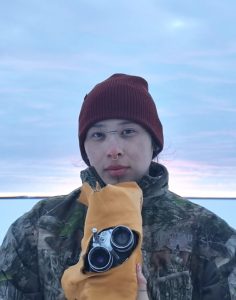
Victoria Redsun
Victoria Redsun // Sahgothé is Denesųłiné & Nîhitho from Etthén Tue (Reindeer Lake). They are a writer & multimedia artist. The spirit of the ndé & tué inspire the creation of their work. They found their voice in filmmaking through mentorships and training. They primarily work in grassroots and independent spaces. They are working towards sovereignty in their homelands.
*BUSH Gallery sponsored
Vance Wright
Vance Wright (they/them) is a reconnecting two-spirit member of the Tl’azt’en Nation, and was raised on the unceded territories of the Sinixt Nation in what is colonially known as Nelson, BC. Currently residing in the occupied and unceded territories of the Musqueam, Squamish, and Tsleil-Waututh Nations in Vancouver, they are an emerging artist, curator and writer. They hold a Bachelor of Fine Arts from Emily Carr University, with a major in Critical and Cultural Practices and a minor in Curatorial Studies.

Alberta Rose W./Ingniq is an Inuvialuk artist, curator, and preparator based in the Treaty 7 region of Alberta, Canada. She earned her Bachelor of Fine Arts with distinction from the Alberta University of the Arts, followed by a preparatory practicum at the Banff Centre for Arts and Creativity. Her practice involves painting, embroidery, beadwork, sculptural installation, video, and photography. She has participated in residencies at the Banff Centre, Contemporary Calgary, and the Calgary Central Library. Her work has been exhibited across Turtle Island. In 2021, Alberta received the honor of being named the TD Indigenous Artist of the Year in Calgary, Alberta.
*sponsored by UVIC: Canada Excellence Research Chair in Decolonial and Transformational Indigenous Art Practices, University of Victoria.
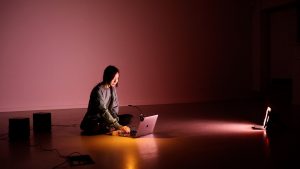 al-yené is an artist from Sakha republic with familial ties to Ebyakh and Tiungiuliu, she was raised in Zyryanka and Yakutsk. al-yené works across different media, but mostly with video and poetry. Her practice is focused on continuity, displacement, gaps and absences within cultural memory of Sakha people and relative northern communities. Her practice draws on personal and familial histories, alongside state archives and media, to reflect on how Indigenous memories are shaped, silenced, carried in bodies and reclaimed.
al-yené is an artist from Sakha republic with familial ties to Ebyakh and Tiungiuliu, she was raised in Zyryanka and Yakutsk. al-yené works across different media, but mostly with video and poetry. Her practice is focused on continuity, displacement, gaps and absences within cultural memory of Sakha people and relative northern communities. Her practice draws on personal and familial histories, alongside state archives and media, to reflect on how Indigenous memories are shaped, silenced, carried in bodies and reclaimed.
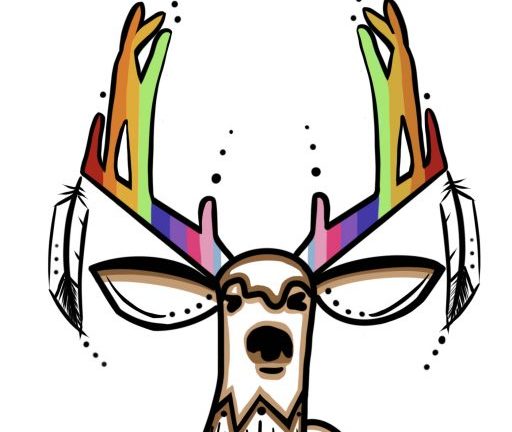
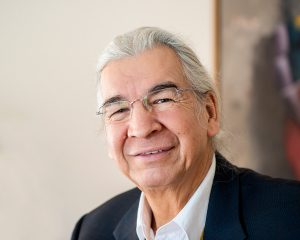 Joseph Naytowhow is a gifted singer/songwriter, accomplished stage and screen actor, orator and storyteller. His work includes voice, music, and storytelling for on-air plays with CBC, MBC, APTN and SCN. He is passionate and committed to the arts including collaborations, film, television, theatre, advisory and teaching as his life’s work.
Joseph Naytowhow is a gifted singer/songwriter, accomplished stage and screen actor, orator and storyteller. His work includes voice, music, and storytelling for on-air plays with CBC, MBC, APTN and SCN. He is passionate and committed to the arts including collaborations, film, television, theatre, advisory and teaching as his life’s work.